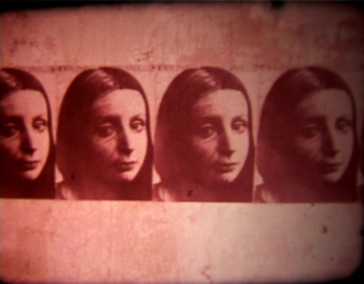
Born in 1945, Grodzisk Mazowiecki (PL). Lives and works in Berlin (DE)

1979
16mm Film transfered to VHS and DVD, colour, sound
durée: 7'15''
Year of Purchase: 2010
Visual poetry and structural cinema developed by Ewa Partum in the early 1970s already implied the presence of the artist, whose statements were often hindered by the very impossibility of language. But these communication problems quickly found an extra-linguistic cause: the condition of alienation experienced by women in the People’s Republic of Poland. Partum started to use her body in order to denounce the aesthetic imperative to which women were being reduced. The same alienation was described by other artists: Art must be beautiful, Artist must be beautiful (1975), Marina Abramović relentlessly repeated as she furiously brushed her hair for 45 minutes, while Sanja Ivekovic showed off the black arrows she painted on her face in order to guide hypothetical cosmetic procedures (Instructions no. 1, 1976). Its use subverted, make-up clearly becomes war paint, which the artist both applies and is subject to.
Ewa Partum’s performance entitled Change. My problem is a problem of a woman (1979) is the culmination and the turning point of a process which began with Change in 1974. The latter was an action in which the artist had half of her face aged using make-up and immortalized in a portrait posted in the streets of Warsaw. Up to that point, Partum had used make-up to glamorize herself, signing various words with her lips outlined in red and pressed against paper as she spoke 1. But in Change. My problem is a problem of a woman, Partum had wrinkles, varicose veins, and grey hair applied over half of her body while, reclining on a white podium, she recited passages from the critic Lucy Lippard and the artist VALIE EXPORT. In an equally premature way, the artist announced as early as 1974 that she was going to do a retrospective—in a hurry perhaps to put an end to the ineluctable devaluation of a body of work suffering from the double disadvantage of the gender and the age of its author. On the floor of this exhibition, there was, however, the affirmation that “An artist has no biography”—a reminder that Partum’s feminist engagement went beyond autobiographical anecdote.
All subsequent performances were done nude, or in the process of disrobing. Some, destined to be performed in the street, were censored and replaced by photomontages. This was the case of the series Self-Identification , launched in 1980 with a film in which the naked artist spies on newly-weds leaving a church. The institution of marriage was criticized again in other actions in which Partum incarnated a bride recruited, sacrificed, and offered up to the control of a patriarchal, Catholic society (Women, marriage is against you, 1981). Although explicit, the artist’s nudity remains cold and impassive: displayed without drama or exhibitionism, it portrays the “naked truth,” freed from the contradictory stereotypes of the virgin myth and the sexual phantasm.
Hélène Meisel
1 My touch is a touch of a woman, 1971.